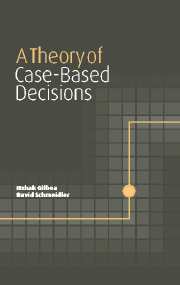6 - Repeated choice
Published online by Cambridge University Press: 22 September 2009
Summary
Cumulative utility maximization
Memory-dependent preferences
The rule of U-maximization was suggested in Section 4 as a way to cope with uncertainty. But it can also be differently interpreted: rather than viewing the aggregation of past experiences in U as providing information regarding uncertain payoffs, it can be viewed as a dynamic model of changing preferences. To highlight this aspect of U-maximization, let us focus on a case with no uncertainty, and where the decision maker encounters a sequence of problems that are, according to her subjective judgment, identical. That is, for each act i Є A there exists a unique outcome ri Є R such that only cases of the form (·, i, ri) may appear in the decision maker's memory with i as their second component. Further, the similarity function between any two problems is constant, say, 1.
Examples of such decisions abound. Every day Mary has to decide where to go for lunch. The problems she is facing on different days are basically identical. Moreover, every choice she makes would lead to a payoff that may be assumed known. John decides every morning whether he should drive to work, use public transportation, or walk. In short, many everyday decisions are of this type. Our goal is to analyze the pattern of choices that would result from U-maximization in these problems.
- Type
- Chapter
- Information
- A Theory of Case-Based Decisions , pp. 125 - 145Publisher: Cambridge University PressPrint publication year: 2001

